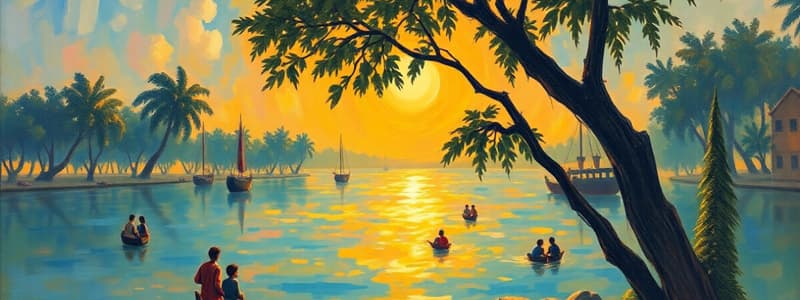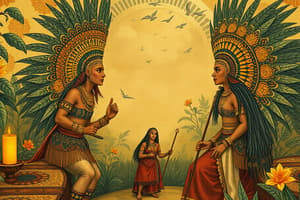Podcast
Questions and Answers
What was the primary diet of communities around Pyramid Lake and Walker River in Nevada?
What was the primary diet of communities around Pyramid Lake and Walker River in Nevada?
- Staple diet of fish supplemented with game and plants (correct)
- Staple diet of plants
- Exclusively game
- Only wild plants
What was crucial for the subsistence strategy of harvesting wild plants and small game?
What was crucial for the subsistence strategy of harvesting wild plants and small game?
- Use of advanced farming techniques
- Permanent settlement in one area
- Intimate knowledge of the land and animals (correct)
- Dependence on imported food
What did trading in the Great Basin primarily involve?
What did trading in the Great Basin primarily involve?
- Obsidian and shells along with other perishable items (correct)
- Exclusively metal tools
- Only food and hides
- Livestock and grains
Which culture is identified as having a horticultural lifestyle in the Great Basin?
Which culture is identified as having a horticultural lifestyle in the Great Basin?
What type of hunting technique became prevalent among Paleo-Indians?
What type of hunting technique became prevalent among Paleo-Indians?
What is a misconception regarding the buffalo hunting culture of North American Indians?
What is a misconception regarding the buffalo hunting culture of North American Indians?
What significant advancement did Paleo-Indians develop for hunting?
What significant advancement did Paleo-Indians develop for hunting?
Which large animals did Paleo-Indians hunt on the Great Plains?
Which large animals did Paleo-Indians hunt on the Great Plains?
What did the 1987 history textbook claim about the Americas before Columbus?
What did the 1987 history textbook claim about the Americas before Columbus?
How did the revised ninth edition of the textbook published in 1995 differ from the earlier version?
How did the revised ninth edition of the textbook published in 1995 differ from the earlier version?
What was one belief about the native population of North America in 1492?
What was one belief about the native population of North America in 1492?
What did Columbus 'discover' according to the text?
What did Columbus 'discover' according to the text?
Which of the following was a story about origins in Native American culture mentioned?
Which of the following was a story about origins in Native American culture mentioned?
What factors have contributed to changes in estimates of the pre-Columbian population of North America?
What factors have contributed to changes in estimates of the pre-Columbian population of North America?
According to the recent calculations, what proportion of the world's population might have lived in the Americas at the time?
According to the recent calculations, what proportion of the world's population might have lived in the Americas at the time?
What was a common misconception about North America's population before modern estimates?
What was a common misconception about North America's population before modern estimates?
What was significant about Cahokia before the end of the eighteenth century?
What was significant about Cahokia before the end of the eighteenth century?
What likely contributed to the decline of Cahokia by the fourteenth century?
What likely contributed to the decline of Cahokia by the fourteenth century?
Which of the following materials was NOT traded to Cahokia?
Which of the following materials was NOT traded to Cahokia?
What impact did the arrival of the Spaniards in the sixteenth century have on Native American chiefdoms?
What impact did the arrival of the Spaniards in the sixteenth century have on Native American chiefdoms?
What evidence of Cahokia can still be seen today?
What evidence of Cahokia can still be seen today?
Which civilization showed significant elements of Mississippian culture until the early eighteenth century?
Which civilization showed significant elements of Mississippian culture until the early eighteenth century?
What type of agricultural practice did the Apalachee and Timucua Indians engage in?
What type of agricultural practice did the Apalachee and Timucua Indians engage in?
What emerged from the ruins of great chiefdoms in the Southeast following contact with Spaniards?
What emerged from the ruins of great chiefdoms in the Southeast following contact with Spaniards?
What significant shift did the Navajos experience over time?
What significant shift did the Navajos experience over time?
When did the Navajos begin to emerge into written history?
When did the Navajos begin to emerge into written history?
What role did communal stories play for ancient Pueblo people?
What role did communal stories play for ancient Pueblo people?
Where did the ancestors of the Navajos migrate from?
Where did the ancestors of the Navajos migrate from?
Which cultural elements did the Navajos adopt over time?
Which cultural elements did the Navajos adopt over time?
How did scholars piece together the history of the Navajos?
How did scholars piece together the history of the Navajos?
What geographical area did the Navajos settle in?
What geographical area did the Navajos settle in?
What did Leslie Marmon Silko emphasize about the stories of ancient Pueblo people?
What did Leslie Marmon Silko emphasize about the stories of ancient Pueblo people?
What does Dinétah, the Navajo homeland, encompass?
What does Dinétah, the Navajo homeland, encompass?
Which sacred mountain is located to the south of Dinétah?
Which sacred mountain is located to the south of Dinétah?
What is emphasized as essential for social harmony according to the stories?
What is emphasized as essential for social harmony according to the stories?
How do the Navajos view their relationship with the land?
How do the Navajos view their relationship with the land?
What role do legends play in Navajo culture?
What role do legends play in Navajo culture?
What do recurrent movements in Navajo stories convey?
What do recurrent movements in Navajo stories convey?
What does the story of the Navajos' journey to the Southwest represent?
What does the story of the Navajos' journey to the Southwest represent?
What is described as a consequence of antisocial behavior in Navajo beliefs?
What is described as a consequence of antisocial behavior in Navajo beliefs?
Study Notes
Pre-Columbian Historical Context
- Early U.S. history textbooks claimed the Americas were "empty" before Columbus, neglecting the civilizations that existed.
- Acknowledgment of diverse civilizations in the Americas emerged in revised editions, yet limited space was allocated to "America before Columbus."
Indigenous Perspectives and Narratives
- Various Native American groups have creation stories, illustrating rich cultural histories predating European arrival.
- Beliefs vary widely: Iroquois view ancestors falling from the sky, while others have emergence from earth or hollows, with archaeological theories suggesting migration via Bering Strait.
Population Estimates and Settlements
- Initial estimates of the Native American population in 1492 were around 1 million; newer techniques suggest figures might range from 2 million to 18 million.
- The combined population of the Americas could account for 20% of the global population at the time, estimated between 43 and 65 million.
Subsistence Strategies and Trade
- Communities developed adept ways to harvest resources, engaging in fishing, hunting, and gathering, reflecting extensive ecological knowledge.
- Trade, including items like shells and obsidian, was vital for social and economic interactions across vast regions since at least 7000 years ago.
Horticulture and Cultural Development
- The Fremont Culture emerged between A.D. 400 and 1300 in regions like Utah and Idaho, introducing corn cultivation among other cultural developments but was relatively short-lived.
Buffalo Hunters and Paleo-Indians
- Paleo-Indians hunted large game on foot in the Great Plains between 12,000 and 8000 B.C., employing advanced stone tools like flaked Clovis points.
- Techniques such as buffalo drives were developed over time, adapting to environmental conditions for effective hunting.
Cahokia: A Center of Civilization
- Cahokia was the largest pre-Columbian settlement north of the Rio Grande, showcasing advanced trade networks and monumental mounds of earth.
- Flourishing until the 14th century, it faced decline due to resource exhaustion, climate changes, and enemy pressures, leading to abandonment prior to Columbus.
Influences and Impact of Spanish Contact
- Mississippian cultures significantly influenced Southeast tribes like the Apalachee and Timucua, who practiced agriculture and lived in permanent settlements.
- Spanish invasions triggered societal collapse, leading to the emergence of historic tribes such as the Caddos and Choctaws from remnants of earlier chiefdoms.
The Navajo Story and Cultural Identity
- The Navajo (Diné) tribe, with roots tracing back to northern Canada, evolved into a significant society integrating agriculture and trade with Pueblos and Spaniards.
- Oral traditions serve to maintain collective memory and cultural identity, connecting the Navajos to their land and ancestral stories.
Sacred Geography and Cosmology
- The Navajo homeland, Dinétah, is defined by four sacred mountains, symbolizing harmony between people and nature, reflecting a worldview that emphasizes balance and good relationships.
- Stories passed through generations articulate cultural knowledge and moral guidelines, shaping communal identity and social norms.
Responsibility and Social Harmony
- Narratives highlight the importance of restoring balance through proper behavior and rituals to ensure societal well-being.
- Adequate relations between genders and community members are crucial for maintaining order and preventing misfortune, reflecting broader moral tenets in Navajo culture.
Studying That Suits You
Use AI to generate personalized quizzes and flashcards to suit your learning preferences.
Description
Explore the misconceptions surrounding the history of the Americas prior to Columbus' arrival. This quiz delves into the civilizations and their achievements that existed long before European contact. Challenge your understanding of early American history and its overlooked narratives.




